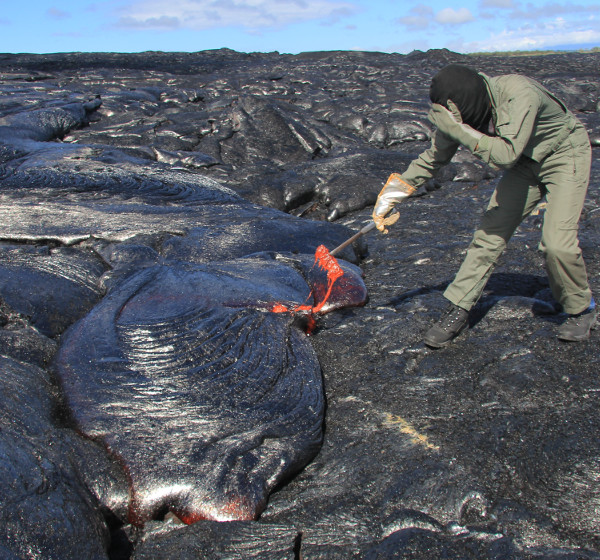Process of collecting molten lava from volcanoes
With only protective gear, a hammer and a bucket of water, geologists have turned the work of dangerous molten lava into a very gentle way.
The process of collecting volcanic lava
Recently, the US Geological Survey (USGS) posted a video of a geologist collecting samples of lava in Kilauea volcano, Hawaii, and the process seemed very simple.
When taking samples, geologists wearing clothes protected by the temperature of the lava can blister the skin from a long distance. They used a steel hammer to scrape the cool outer shell and then remove the molten lava with a temperature of about 1,150 degrees Celsius.

A geologist is sampling lava.(Photo: USGS).
Because the steel hammer is relatively cold, the lava on the hammer hardens slightly and easily slides from the hammer into the bucket of water. Melting lava makes the water boil instantly. According to USGS, geologists need to cool lava with water very quickly to avoid chemical changes from forming crystals during slow cooling.
A number of samples were stored while the rest was analyzed to determine the chemical composition and eruption temperature. Analyzing lava samples helps scientists at the Hawaii Volcanic Observatory learn about the activity inside Kilauea volcano.
"For example, we can distinguish between magma rising very fast from deep in the earth and magma stored for many years in shallow tanks inside volcanoes," said Janet Babb, USGS geologist at the Station. Observe the Hawaii Volcano, share with The Huffington Post.
- Decipher the mystery who runs on molten lava
- Why does lava melt in the Earth's heart without causing the Earth's crust to melt?
- What happens if 1500 volcanoes on Earth erupt
- The volcano roared without rest for 29 years
- 2015: The rise of volcanoes
- Explain the danger that happens when pouring hot copper into an iceberg
- Hot lava rivers like the Sun flow from Canada to Russia
- Explore volcanic lava lakes that are 1,000 degrees Celsius hot
- Hawaii: A series of 'lava' hot lava flows into the ocean
- Found the ray-shaped Elysium volcano on Mars
- Uncover the mysterious veil of volcanic ranges underneath the Coral Sea
- Can accurately guess the time when volcanoes are active
 Is the magnetic North Pole shift dangerous to humanity?
Is the magnetic North Pole shift dangerous to humanity? Washington legalizes the recycling of human bodies into fertilizer
Washington legalizes the recycling of human bodies into fertilizer Lightning stone - the mysterious guest
Lightning stone - the mysterious guest Stunned by the mysterious sunset, strange appearance
Stunned by the mysterious sunset, strange appearance Life could exist on Jupiter's moon
Life could exist on Jupiter's moon  Red hot lava flowing on snow causes confusion
Red hot lava flowing on snow causes confusion  Mysterious people lived in lava tubes 7,000 years ago in Arabia
Mysterious people lived in lava tubes 7,000 years ago in Arabia  Robot captures 320,000m2 lava field under the sea
Robot captures 320,000m2 lava field under the sea  Scientists reproduce the lava explosion
Scientists reproduce the lava explosion  Discovered an unprecedented depth of volcanic lava
Discovered an unprecedented depth of volcanic lava 